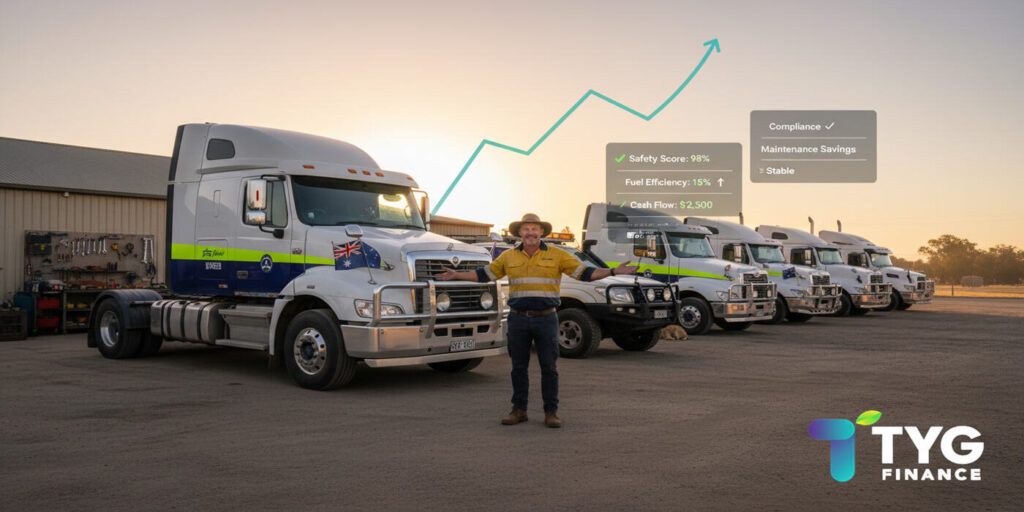Why 2025 Could Be a Turning Point
For asset-backed businesses across transport, mining, agriculture, and construction, fleets are more than operational assets — they are central to growth and compliance. In 2025, operators may find themselves navigating a period of rapid change as emerging technologies and regulatory updates reshape both safety and efficiency standards.
From advanced driver-assistance systems to new government compliance requirements, these trends may influence how businesses plan for fleet upgrades, structure financing, and maintain competitive positioning.
This article explores several key developments Australian businesses could monitor in 2025, with an emphasis on how they might affect fleet management strategies.
Trend 1: Advanced Driver Safety Technologies Becoming Standard
Automotive technology continues to evolve, and many features once considered optional extras are now entering the mainstream. By 2025, it is expected that advanced driver-assistance systems (ADAS) — including collision avoidance, lane-keeping assistance, and fatigue detection — will become more widely available across commercial fleets.
For operators, this trend could mean:
- Enhanced compliance with safety expectations outlined in government transport safety updates.
- Potential insurance benefits, as vehicles equipped with safety technologies often qualify for reduced premiums.
- Shifts in financing priorities, with businesses weighing the cost of safety technology against possible long-term savings.
Some businesses may even begin replacing older vehicles earlier than planned to take advantage of these systems. For more on aligning safety upgrades with business outcomes, see our full review of spring fleet safety and efficiency challenges.
For structured fleet upgrade solutions, explore our Fleet Finance options.
Trend 2: Data-Driven Fleet Efficiency Gain
Telematics, AI-driven route optimisation, and predictive maintenance tools are moving from optional add-ons to essential business tools. As these technologies advance, operators may see new opportunities to:
- Monitor driver performance in real time.
- Reduce fuel and energy consumption through smarter route planning.
- Predict mechanical issues before costly breakdowns occur.
For businesses in transport and logistics especially, data-driven decision-making may become a central part of maintaining efficiency and competitiveness.
However, implementing these systems may require upfront capital — something many operators consider managing through tailored financing solutions.
Trend 3: Regulatory Pressure on Emissions and Safety Compliance
Regulatory bodies are placing growing emphasis on emissions reduction and safety standards. Updated heavy vehicle regulations and emissions targets could encourage businesses to adopt more efficient or hybrid-powered vehicles sooner than anticipated.
Key implications may include:
- Stricter fleet compliance audits, requiring more detailed reporting.
- Incentives or penalties linked to emissions levels.
- Greater need for modern vehicles capable of meeting evolving standards.
Operators keeping a close eye on government transport safety updates may find themselves better prepared to adapt quickly.
Trend 4: Alternative Energy Fleets on the Horizon
While electric and hydrogen-powered vehicles are still emerging in heavy-duty contexts, 2025 may mark a shift toward broader adoption. Fleet operators in metropolitan areas could begin experimenting with electric delivery vans, while larger industries may pilot hydrogen trucks or hybrid utes.
This transition will not happen overnight, but forward-thinking operators may begin considering:
- Whether financing electric or hybrid vehicles makes sense in their duty cycles.
- Infrastructure requirements for charging or refuelling.
- Residual value trends for alternative energy vehicles, as resale markets mature.
Automotive tech forecast reports suggest that battery efficiency improvements and cost reductions could accelerate adoption over the next five years.
Trend 5: Financing Strategies Becoming More Strategic
With fleets becoming more complex and costly, financing is increasingly seen not just as a transaction but as a strategic tool. In 2025, businesses may seek:
- Flexible repayment schedules tied to seasonal revenue cycles.
- Facilities allowing staged fleet replacement, balancing cost with operational needs.
- Pre-approval options to act quickly on new fleet opportunities.
Some operators are even exploring financing for specialised assets like prestige or rare vehicles used for executive or branding purposes. In all these cases, balancing operational needs with total cost of ownership remains a central theme in modern fleet management.
See how tailored Luxury & Classic Vehicle Finance solutions could complement broader fleet strategies.
Trend 6: Cultural Shifts in Driver Expectations
Another often-overlooked factor is the human element. Drivers increasingly expect employers to invest in safe, reliable, and comfortable vehicles. As competition for skilled drivers intensifies, businesses that modernise fleets may find themselves better positioned to attract and retain talent.
Emerging expectations may include:
- Access to vehicles with ergonomic design and fatigue-reducing technology.
- Assurance that employers are committed to workplace safety.
- Improved digital integration for logistics and communications.
This cultural shift could make fleet upgrades not just a financial choice, but a workforce strategy.
Practical Ways Operators Might Respond
- Monitor regulatory updates closely to anticipate compliance changes.
- Explore TCO vs. sticker price when evaluating vehicles with new technologies.
- Pilot alternative energy vehicles where operationally feasible.
- Leverage financing structures to smooth capital investment.
- Align fleet upgrades with driver expectations to strengthen retention.
For a detailed guide to aligning replacement decisions with duty cycles and long-term value, explore our fleet planning insights.
Staying Ahead in a Changing Landscape
Fleet management in 2025 is not just about keeping vehicles on the road — it is about adapting to technological, regulatory, and cultural shifts that shape both cost and compliance.
For asset-backed businesses, this means thinking beyond the next purchase price. Emerging trends point to a world where safety technology, emissions standards, and financing strategies will increasingly determine who stays competitive. See how a staged, proactive approach to upgrades can reduce costs and improve driver safety in practice.
Get Pre-Approved Today with TYG Finance and prepare your business for the fleet trends shaping tomorrow.


